Adjusted Basis
Adjusted basis is your basis increased or decreased by certain amounts.
To figure your adjusted basis, you can use Worksheet 1. A filled-in example of that worksheet is included in a comprehensive Illustrated Example at the end of this chapter. Table 1 explains how to use the worksheet in certain special situations.
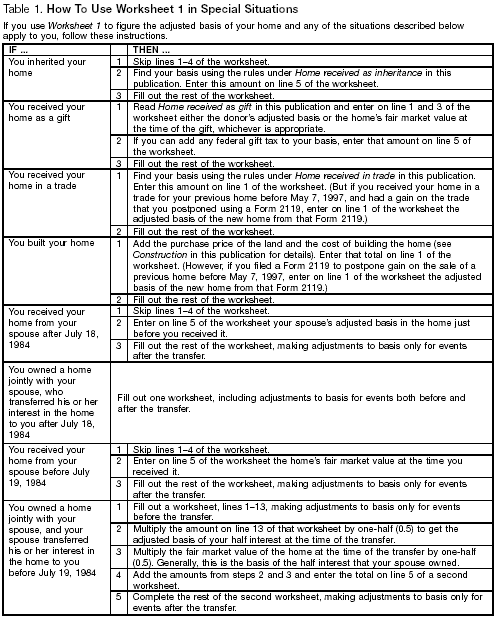
Table 1. How to Use the Adjusted Basis of Home Sold Worksheet in Special Situations
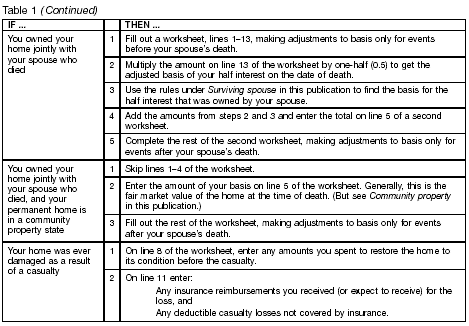
Table 1 (continued)
Increases to basis. These include any:
- Additions and other improvements that have a useful life of more than 1 year,
- Special assessments for local improvements, and
- Amounts you spent after a casualty to restore damaged property.
Decreases to basis. These include any:
- Gain you postponed from the sale of a previous home before May 7, 1997,
- Deductible casualty losses,
- Insurance payments you received or expect to receive for casualty losses,
- Payments you received for granting an easement or right-of-way,
- Depreciation allowed or allowable if you used your home for business or rental purposes,
- Residential energy credit (generally allowed from 1977 through 1987) claimed for the cost of energy improvements that you added to the basis of your home,
- Adoption credit you claimed for improvements added to the basis of your home,
- Nontaxable payments from an adoption assistance program of your employer that you used for improvements you added to the basis of your home,
- First-time homebuyers credit (allowed to certain first-time buyers of a home in the District of Columbia), and
- Energy conservation subsidy excluded from your gross income because you received it (directly or indirectly) from a public utility after 1992 to buy or install any energy conservation measure. An energy conservation measure is an installation or modification that is primarily designed either to reduce consumption of electricity or natural gas or to improve the management of energy demand for a home.
Improvements. These add to the value of your home, prolong its useful life, or adapt it to new uses. You add the cost of additions and other improvements to the basis of your property.
Examples. Putting a recreation room or another bathroom in your unfinished basement, putting up a new fence, putting in new plumbing or wiring, putting on a new roof, or paving your unpaved driveway are improvements. An addition to your house, such as a new deck, a sunroom, or a new garage, is also an improvement.
The following chart lists some other examples of improvements.
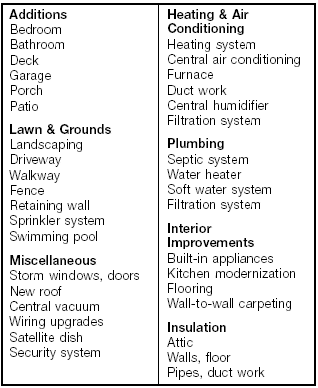
Table 3. Examples of Improvements
Improvements no longer part of home. Your home's adjusted basis does not include the cost of any improvements that are no longer part of the home.
Example. You put wall-to-wall carpeting in your home 15 years ago. Later, you replaced that carpeting with new wall-to-wall carpeting. The cost of the old carpeting you replaced is no longer part of your home's adjusted basis.
Repairs. These maintain your home in good condition but do not add to its value or prolong its life. You do not add their cost to the basis of your property.
Examples. Repainting your house inside or outside, fixing your gutters or floors, repairing leaks or plastering, and replacing broken window panes are examples of repairs.
Exception. The entire job is considered an improvement if items that would otherwise be considered repairs are done as part of an extensive remodeling or restoration of your home.
 Recordkeeping. You should keep records to prove your home's adjusted basis. Ordinarily, you must keep records for 3 years after the due date for filing your return for the tax year in which you sold your home. But if you sold a home before May 7, 1997, and postponed tax on any gain, the basis of that home affects the basis of the new home you bought. Keep records proving the basis of both homes as long as they are needed for tax purposes.
Recordkeeping. You should keep records to prove your home's adjusted basis. Ordinarily, you must keep records for 3 years after the due date for filing your return for the tax year in which you sold your home. But if you sold a home before May 7, 1997, and postponed tax on any gain, the basis of that home affects the basis of the new home you bought. Keep records proving the basis of both homes as long as they are needed for tax purposes.
The records you should keep include:
- Proof of the home's purchase price and purchase expenses,
- Receipts and other records for all improvements, additions, and other items that affect the home's adjusted basis,
- Any worksheets you used to figure the adjusted basis of the home you sold, the gain or loss on the sale, the exclusion, and the taxable gain,
- Any Form 2119, Sale of your Home, that you filed to postpone gain from the sale of a previous home before May 7, 1997, and
- Any worksheets you used to prepare Form 2119, such as the Adjusted Basis of Home Sold Worksheet or the Capital Improvements Worksheet from the Form 2119 instructions.
Excluding the Gain
You may qualify to exclude from your income all or part of any gain from the sale of your main home. This means that, if you qualify, you will not have to pay tax on the gain up to the limit described under Maximum Amount of Exclusion, next. To qualify, you must meet the ownership and use tests described later.
You can choose not to take the exclusion. In that case, you must include in income your entire gain.
You can use Worksheet 2 to figure the amount of your exclusion and your taxable gain, if any.
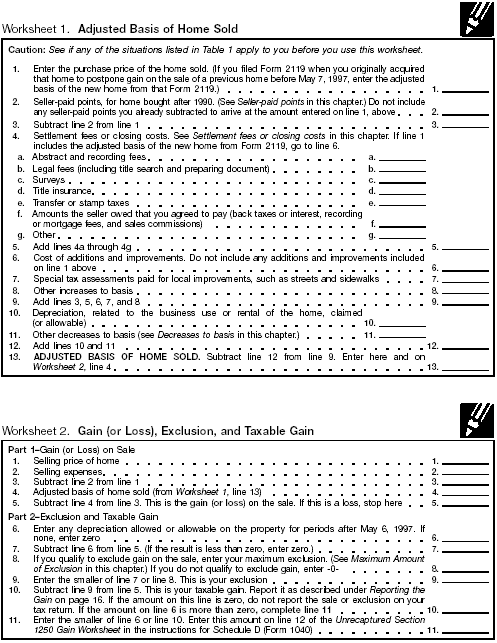
Worksheet 1. Adjusted Basis of Home Sold and Worksheet 2. Gain (or Loss), Exclusion and Taxable Gain
Maximum Amount of Exclusion
You can exclude the entire gain on the sale of your main home up to:
- $250,000, or
- $500,000 if all of the following are true.
- You are married and file a joint return for the year.
- Either you or your spouse meets the ownership test.
- Both you and your spouse meet the use test.
- During the 2-year period ending on the date of the sale, neither you nor your spouse excluded gain from the sale of another home.
Reduced Maximum Exclusion
You can claim an exclusion, but the maximum amount of gain you can exclude will be reduced, if either of the following is true.
- You did not meet the ownership and use tests, but you sold the home due to:
- A change in place of employment,
- Health, or
- Unforeseen circumstances, to the extent provided in regulations (as discussed below).
- Your exclusion would have been disallowed because of the rule described in More Than One Home Sold During 2-Year Period, later, except that you sold the home due to:
- A change in place of employment,
- Health, or
- Unforeseen circumstances, to the extent provided in regulations (as discussed below).
Use Worksheet 3 to figure your reduced maximum exclusion.
Unforeseen circumstances. The IRS has not issued regulations defining unforeseen circumstances. You cannot claim an exclusion based on unforeseen circumstances until the IRS issues final regulations or other appropriate guidance.
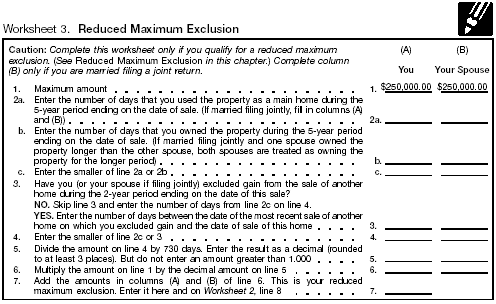
Reduced Maximum Exclusion
More Than One Home Sold During 2-Year Period
You cannot exclude gain on the sale of your home if, during the 2-year period ending on the date of the sale, you sold another home at a gain and excluded all or part of that gain. If you cannot exclude the gain, you must include it in your income.
However, you can still claim an exclusion if you sold the home due to:
- A change in place of employment,
- Health, or
- Unforeseen circumstances, to the extent provided in regulations (as discussed earlier).
The maximum amount you can exclude is reduced. See Reduced Maximum Exclusion, earlier.
Example 1. In September 1999, Paul and Nadine bought a new home. In November 1999, they sold their old home at a $40,000 gain. They had owned and lived in the old home for 4 years. They excluded the gain on the sale.
On October 1, 2001, Paul and Nadine sold the home they purchased in September 1999 at a $15,000 gain. The sale was not due to a change in place of employment or health. Because Paul and Nadine had excluded gain on the sale of another home within the 2-year period ending on October 1, 2001, they cannot exclude the gain on this sale.
Example 2. The facts are the same as in Example 1 except that Paul and Nadine did not sell the home purchased in September 1999 until December 3, 2001. Because they had not excluded gain on the sale of another home within the 2-year period ending on December 3, 2001, they can exclude the gain on this sale.
Ownership and Use Tests
To claim the exclusion, you must meet the ownership and use tests. This means that during the 5-year period ending on the date of the sale, you must have:
- Owned the home for at least 2 years (the ownership test), and
- Lived in the home as your main home for at least 2 years (the use test).
Exception. If you owned and lived in the property as your main home for less than 2 years, you can still claim an exclusion in some cases. The maximum amount you can exclude will be reduced. See Reduced Maximum Exclusion, earlier.
Example 1 - met use test but not ownership test. From 1992 through August 2000 Donna lived with her parents in a house that her parents owned. On September 1, 2000, she bought this house from her parents. She continued to live there until December 14, 2001, when she sold it at a gain. Although Donna lived in the property as her main home for more than 2 years, she did not own it for the required 2 years. She cannot exclude any part of her gain on the sale, unless she sold the property due to a change in place of employment or health.
Example 2 - change in place of employment. Amanda, who is single, bought her first home in August 1999. In December 2000 the company she worked for notified her that she would be transferred to another town in 2001. She continued to live in the home until June 2001, when she sold it at a gain and moved to the new town. Because she owned and lived in the home less than 2 years, she does not meet the ownership and use tests. However, she qualifies to exclude gain because she sold the home due to a change in place of employment. She can use Worksheet 3 to figure the maximum amount of gain she can exclude. It will be less than $250,000.
Period of ownership and use. The required 2 years of ownership and use during the 5-year period ending on the date of the sale do not have to be continuous.
You meet the tests if you can show that you owned and lived in the property as your main home for either 24 full months or 730 days (365 × 2) during the 5-year period ending on the date of sale.
Example. Susan bought and moved into a house in July 1997. She lived there for 13 months and then moved in with a friend. She moved back into her own house in 2000 and lived there for 12 months until she sold it in July 2001. Susan meets the ownership and use tests because, during the 5-year period ending on the date of sale, she owned the house for 4 years and lived in it for a total of 25 months.
Temporary absence. Short temporary absences for vacations or other seasonal absences, even if you rent out the property during the absences, are counted as periods of use.
Example. Professor Paul Beard, who is single, bought and moved into a house on August 28, 1998. He lived in it as his main home continuously until January 5, 2000, when he went abroad for a 1-year sabbatical leave. During part of the period of leave, the house was unoccupied, and during the rest of the period, he rented it. On January 5, 2001, he sold the house at a gain. Because his leave was not a short temporary absence, he cannot include the period of leave to meet the 2-year use test. He cannot exclude any part of his gain, unless he sold the house due to a change in place of employment or health, as explained under Reduced Maximum Exclusion, earlier. Even if he did sell the house due to a change in place of employment or health, he cannot exclude the part of the gain equal to the depreciation he claimed while renting the house. See Depreciation for business use after May 6, 1997, later.
Ownership and use tests met at different times. You can meet the ownership and use tests during different 2-year periods. However, you must meet both tests during the 5-year period ending on the date of the sale.
Example. In 1992, Helen Jones lived in a rented apartment. The apartment building was later changed to a condominium, and she bought her apartment on December 1, 1998. In 1999, Helen became ill and on April 14 of that year she moved to her daughter's home. On July 10, 2001, while still living in her daughter's home, she sold her apartment.
Helen can exclude gain on the sale of her apartment because she met the ownership and use tests. Her 5-year period is from July 11, 1996, to July 10, 2001, the date she sold the apartment. She owned her apartment from December 1, 1998, to July 10, 2001 (more than 2 years). She lived in the apartment from July 11, 1996 (the beginning of the 5-year period), to April 14, 1999 (more than 2 years).
Cooperative apartment. If you sold stock in a cooperative housing corporation, the ownership and use tests are met if, during the 5-year period ending on the date of sale, you:
- Owned the stock for at least 2 years, and
- Lived in the house or apartment that the stock entitles you to occupy as your main home for at least 2 years.
Exception for individuals with a disability. There is an exception to the use test if, during the 5-year period before the sale of your home:
- You become physically or mentally unable to care for yourself, and
- You owned and lived in your home as your main home for a total of at least 1 year.
Under this exception, you are considered to live in your home during any time that you own the home and live in a facility (including a nursing home) that is licensed by a state or political subdivision to care for persons in your condition.
If you meet this exception to the use test, you still have to meet the 2-out-of-5-year ownership test to claim the exclusion.
Gain postponed on sale of previous home. For the ownership and use tests, you may be able to add the time you owned and lived in a previous home to the time you lived in the home on which you wish to exclude gain. You can do this if you postponed all or part of the gain on the sale of the previous home (as described under Rules That Provided for Postponing Gain in chapter 3) because of buying the home on which you wish to exclude gain.
Previous home destroyed or condemned. For the ownership and use tests, you add the time you owned and lived in a previous home that was destroyed or condemned to the time you owned and lived in the home on which you wish to exclude gain. This rule applies if any part of the basis of the home you sold depended on the basis of the destroyed or condemned home. Otherwise, you must have owned and lived in the same home for 2 of the 5 years before the sale to qualify for the exclusion.
Married Persons
If you and your spouse file a joint return for the year of sale, you can exclude gain if either spouse meets the ownership and use tests. (But see Maximum Amount of Exclusion, earlier.)
Example 1 - one spouse sells a home. Emily sells her home in June 2001. She marries Jamie later in the year. She meets the ownership and use tests, but Jamie does not. Emily can exclude up to $250,000 of gain on a separate or joint return for 2001.
Example 2 - each spouse sells a home. The facts are the same as in Example 1 except that Jamie also sells a home. He meets the ownership and use tests on his home. Emily and Jamie can each exclude up to $250,000 of gain.
Death of spouse before sale. If your spouse died before the date of sale, you are considered to have owned and lived in the property as your main home during any period of time when your spouse owned and lived in it as a main home.
Home transferred from spouse. If your home was transferred to you by your spouse (or former spouse if the transfer was incident to divorce), you are considered to have owned it during any period of time when your spouse owned it.
Use of home after divorce. You are considered to have used property as your main home during any period when:
- You owned it, and
- Your spouse or former spouse is allowed to live in it under a divorce or separation instrument.
Business Use or Rental of Home
You may be able to exclude your gain from the sale of a home that you have used for business or to produce rental income. But you must meet the ownership and use tests.
Example 1. On May 30, 1995, Amy bought a house. She moved in on that date and lived in it until May 31, 1997, when she moved out of the house and put it up for rent. The house was rented from June 1, 1997, to March 31, 1999. Amy moved back into the house on April 1, 1999, and lived there until she sold it on January 31, 2001. During the 5-year period ending on the date of the sale (February 1, 1996 - January 31, 2001), Amy owned and lived in the house for more than 2 years as shown in the table below.
| Five Year Period |
Used as Home |
Used as Rental |
| 2/1/96 - 5/31/97 |
16 months |
|
| 6/1/97 - 3/31/99 |
|
22 months |
| 4/1/99 - 1/31/01 |
22 months |
|
| |
38 months |
22 months |
Amy can exclude gain up to $250,000. However, she cannot exclude the part of the gain equal to the depreciation she claimed, or should have claimed, for renting the house, as explained after Example 2.
Example 2. William owned and used a house as his main home from 1995 through 1998. On January 1, 1999, he moved to another state. He rented his house from that date until April 30, 2001, when he sold it. During the 5-year period ending on the date of sale (May 1, 1996-April 30, 2001), William owned and lived in the house for 32 months (more than 2 years). He can exclude gain up to $250,000. However, he cannot exclude the part of the gain equal to the depreciation he claimed for renting the house, as explained next.
Depreciation for business use after May 6, 1997. If you were entitled to take depreciation deductions because you used your home for business purposes or as rental property, you cannot exclude the part of your gain equal to any depreciation allowed or allowable as a deduction for periods after May 6, 1997. If you can show by adequate records or other evidence that the depreciation deduction allowed was less than the amount allowable, the amount you cannot exclude is the smaller figure.
Example. Ray sold his main home in 2001 at a $30,000 gain. He meets the ownership and use tests to exclude the gain from his income. However, he used part of the home for business in 2000 and claimed $500 depreciation. He can exclude $29,500 ($30,000 - $500) of his gain. He has a taxable gain of $500.
Property used partly as your home and partly for business or rental during the year of sale. In the year of sale you may have used part of your property as your home and part of it for business or to produce income. Examples are:
- A working farm on which your house was located,
- An apartment building in which you lived in one unit and rented the others,
- A store building with an upstairs apartment in which you lived, or
- A home with a room used for business (home office) or to produce income.
If you sell the entire property, you should consider the transaction as the sale of two properties. The sale of the part of your property used for business or rental is reported on Form 4797.
To determine the amounts to report on Form 4797, you must divide your selling price, selling expenses, and basis between the part of the property used for business or rental and the part used as your home. In the same way, if you qualify to exclude any of the gain on the business or rental part of your home, also divide your maximum exclusion between that part of the property and the part used as your home. If you want to use Worksheet 2 to figure your exclusion and taxable gain from each part, fill out a separate Worksheet 2 (Part 2) for each.
Excluding gain on the business or rental part of your home. You generally can exclude gain on the part of your home used for business or rental if you owned and lived in that part of the home for at least 2 years during the 5-year period ending on the date of the sale. If you used a separate Worksheet 2 (Part 2) to figure the exclusion for the business or rental part, do not fill out lines 10 and 11 of that Worksheet 2. Fill it out only through line 9. Then fill out Form 4797. Enter the exclusion for the business or rental part on Form 4797 as explained in the Form 4797 instructions. If you use Part IV of Schedule D (Form 1040) to figure your tax, first fill out the Unrecaptured Section 1250 Gain Worksheet in the Schedule D instructions.
Example. You sold your home on November 1, 2001. You had bought the home in 1991 and had owned and lived in it the entire 5-year period ending on the date of sale. For the first 2½ years of that period, you used the entire house as your main home. For the last 21/4 years, you used ¾ (75%) of the house as your main home and ¼ (25%) of the house for business. Your records show:
| Purchase price |
$ 80,000 |
| Depreciation (on business part; all after 5/7/1997) |
1,363 |
| Selling price |
160,000 |
| Selling expenses |
10,000 |
Because you meet the ownership and use tests for the entire house, you can claim the exclusion for both the home and business parts. You start by finding the adjusted basis of each part. You determine that three-fourths (75%) of your purchase price was for the part used as your home; one-fourth (25%) was for the part used for business.
| |
Personal (3/4) |
Business (1/4) |
| Purchase price |
$60,000 |
$20,000 |
| Minus: Depreciation |
-0- |
1,363 |
| Adjusted basis |
$60,000 |
$18,637 |
Next, you figure the gain on each part, dividing your selling price and selling expenses between the two parts.
| |
|
Personal (3/4) |
Business (1/4) |
| Selling price |
|
$120,000 |
$40,000 |
| Minus: Selling expenses |
|
7,500 |
2,500 |
| |
|
112,500 |
37,500 |
| Minus: Adjusted basis |
|
60,000 |
18,637 |
| |
Gain |
$ 52,500 |
$18,863 |
Then, to figure your taxable gain and exclusion on each part, you decide to fill out a separate Worksheet 2 (Part 2) for each part, dividing your maximum exclusion between the two parts. You are single, so your maximum exclusion is $250,000.
| |
|
Personal (3/4) |
Business (1/4) |
| Part 2 - Exclusion and
Taxable Gain |
| 6) |
Depreciation after May 6, 1997 |
$-0- |
$1,363 |
| 7) |
Subtract line 6 from gain |
52,500 |
17,500 |
| 8) |
Maximum exclusion |
$187,500 |
$62,500 |
| 9) |
Exclusion (Smaller of line 7 or line 8) |
52,500 |
17,500 |
| 10) |
Taxable gain (gain minus line 9) |
-0- |
* |
| 11) |
Smaller of line 6 or line 10 |
-0- |
* |
| * Lines 10 and 11 do
not need to be filled out for the business part. |
The gain from the part used as your home does not have to be reported on your return, because you can exclude all of it. You report the gain from the business part ($18,863) in Part III of Form 4797. You enter your exclusion ($17,500) on line 2 of Form 4797. Your taxable gain from the business part is $1,363 ($18,863 - $17,500).
Previous | First | Next
Publication Index | 2002 Tax Help Archives | Tax Help Archives | Home
